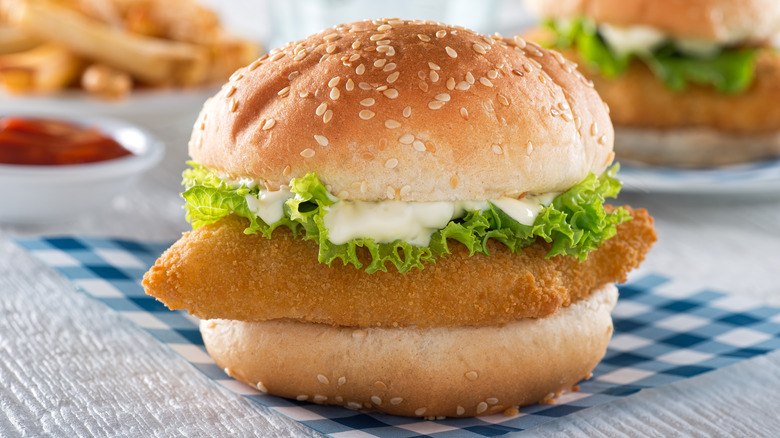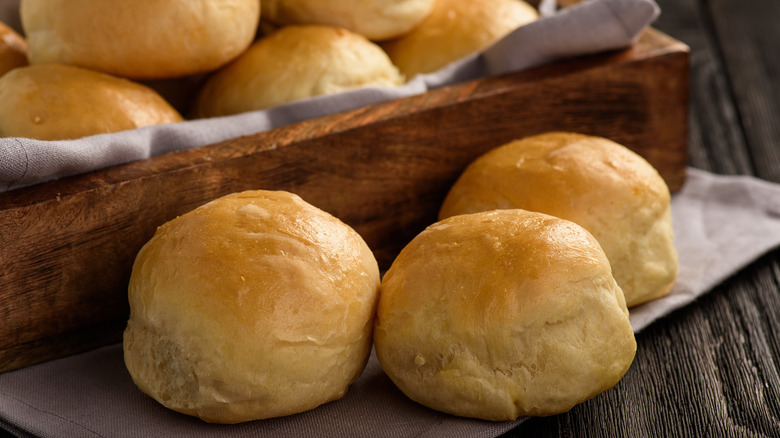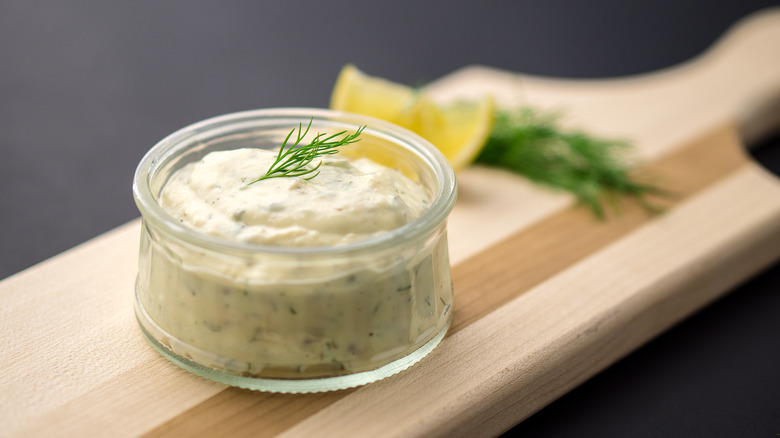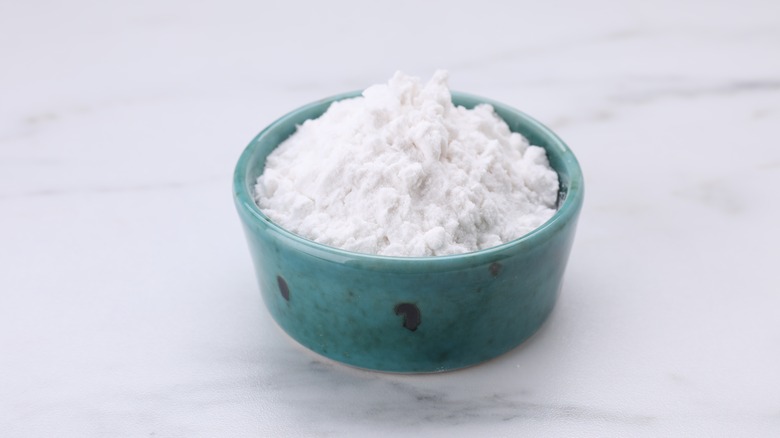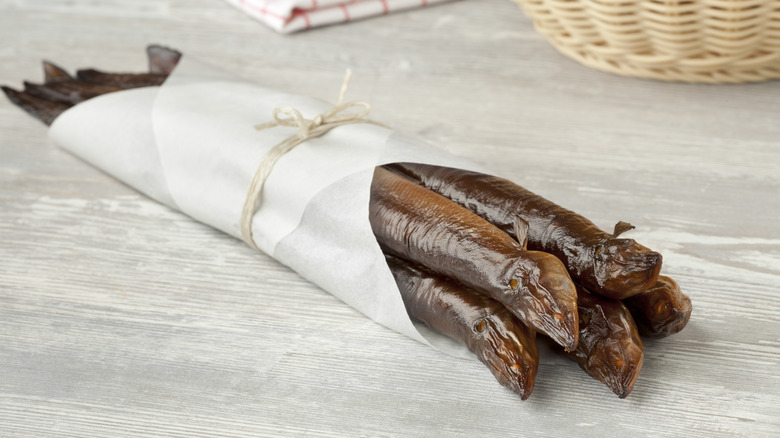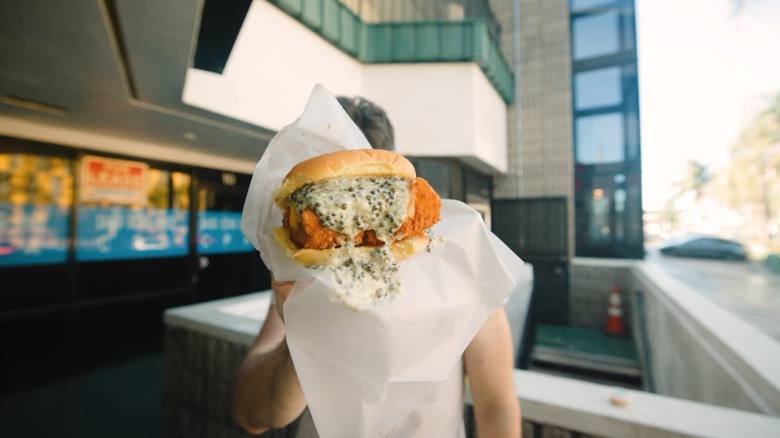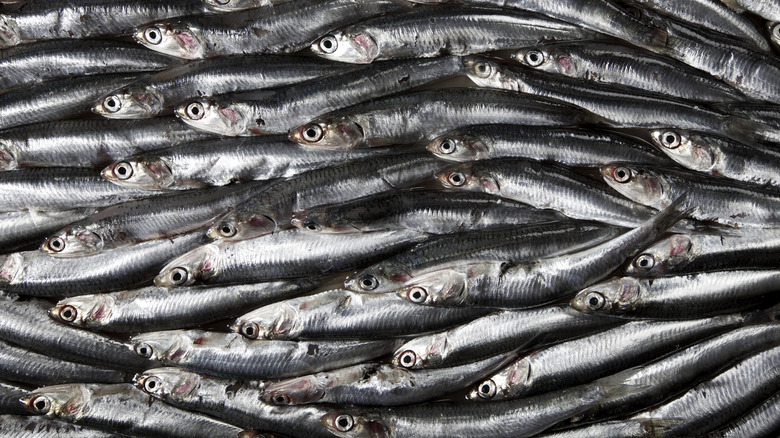Why Restaurant Fish Sandwiches Always Taste Better Than Those You Make At Home
For most Americans, the term 'fish sandwich' will bring to mind McDonald's Filet-O-Fish. This famous sandwich was invented in 1963 as a means of attracting Catholics to McDonald's on Fridays during Lent when many Catholics choose not to consume the meat of land or air animals. Filet-O-Fish remains on the McDonald's menu today. Its longevity is in sharp contrast to other McDonald's fish products like Fish McBites, which were discontinued after only three months. What's more, Filet-O-Fish is still popular; approximately 300 million of the sandwiches are sold by McDonald's every year. In fact, the sandwich has become so iconic that versions of it have popped up in a variety of restaurants across the country.
The fish sandwiches served in America's restaurants vary with each chef putting their own spin on the dish. That being said, there are a few common tricks professional chefs use to ensure their fish sandwiches always taste better than those made at home. Thankfully, many of these tricks can be adopted by home cooks, giving them the ability to produce restaurant-quality fish sandwiches from the comfort of their own home.
They use fresh fish
The main reason why restaurant fish sandwiches taste better than homemade ones is because restaurants have access to fresher fish. This is especially true in landlocked cities such as St. Louis where, thanks to air freight, restaurants are able to serve fish that have only been dead for about two days. This is far fresher than the fish that's available to the public in grocery stores. In fact, tests conducted by the BBC found that some fish sold via grocery stores had been dead for up to 20 days. Most fish sandwiches call for flaky, white fish to be used, such as haddock. These fish taste much better when fresh and the superior flavor of a fish that's been killed recently is noticeable in the finished sandwich.
Home cooks looking to produce similarly fresh-tasting fish sandwiches are often better off purchasing frozen fish from grocery stores as opposed to defrosted fish. This is especially true if they do not live near the coast or are purchasing an imported species. The reason for this is simple: frozen fish are often better preserved. This notion was explained to Epicurious by Gavin Gibbons, spokesman for the National Fisheries Institute: "The clock never moves backward when it comes to freshness. If a fish is caught, handled well and frozen immediately, you literally stop the clock. You freeze in the freshness."
Restaurants use good quality bread
Good quality bread can make or break a sandwich. Those working in restaurants understand this and often use high-quality bread to improve their fish sandwiches. Generally speaking, there are two types of bread professional chefs turn to when making fish sandwiches: brioche buns and potato rolls. Chef Todd Ginsberg highlighted why he likes the former in an interview with The Takeout: "A real brioche bun is wonderful, for the right sandwich. They tend to be a little more delicate and squishy, as well as a little bit sweeter than a regular bun." This slightly sweet flavor is a hallmark of McDonald's Filet-O-Fish and has consequently become a key feature many people look for when eating fish sandwiches.
That being said, the potato roll is the preferred bread of several leading restaurants that serve fish sandwiches. These include Clamato which is located in Paris and the now-shuttered New York restaurant The Jones. Establishments such as Clamato choose to use potato rolls because they are lighter than brioche buns and absorb the liquid components of the sandwich better. Their soft texture also provides a nice contrast to the crisp, fried fish.
If desiring to make restaurant-style fish sandwiches, home cooks are encouraged to use either brioche or potato rolls as these offer a far superior eating experience to regular buns. Both can be bought in grocery stores and are better when toasted.
They make their own sauces
Tartar sauce is regularly used in fish sandwiches across the United States due to its well-known ability to cut through fried fish's richness. When making fish sandwiches at home, most people simply use store-bought tartar sauce. However, those working in professional kitchens usually use homemade tartar sauce as it boasts a superior flavor.
Although recipes vary, most involve combining mayonnaise with diced dill pickles, capers, and herbs. Other chefs put their own spin on the sauce by adding lesser-known ingredients. At Daybird, for example, a fish sandwich is topped with yuzu-flavored tartar sauce. While making it by hand gives chefs control over how the sauce tastes, it also allows them to dictate the sauce's other characteristics including how rich it is. Bertrand Grébault, chef at Clamato, explained how he manages tartar sauce's richness in an interview with Vice: "Use the same amount of mayonnaise as add-ins. That makes the sauce less heavy and adds acidity, salt, and a little bit of heat."
Home cooks should also take the time to develop and make their own sauce. Aside from improving the taste of their fish sandwich this also allows the dish to be built to their exact preferences; something even the best restaurants cannot do.
They use beer batters
Even the best quality fish is ruined when it's cooked in a poor-quality batter. These have a tendency to be tough, overly thick, and are often unable to evenly coat the fish. To prevent this from happening, many chefs add beer to the mixture, creating a batter that evenly coats the entirety of the fish and forms a crisp, thin, and well-browned shell when cooked.
There are three reasons for adding beer. The first is that the acidic nature of the beer lowers the PH of the batter. This, in turn, inhibits the formation of gluten, preventing the batter from becoming unpleasantly tough. The second reason for adding beer to the batter is that the carbonation causes the batter to expand. This gives it a lighter texture than batters that do not contain a carbonated beverage. Thirdly, the sugars present in beer ensure the batter develops a lovely, browned appearance during cooking.
For these reasons, beer-battered fish sandwiches are lighter, crisper, and more enjoyable to eat. As a result, anyone seeking to make fish sandwiches of restaurant quality should consider beer battering their fish.
Restaurants use a mixture of cornstarch and flour
When battering fish at home, many cooks opt for all-purpose flour as their thickener. This produces a passable batter that coats the fish well. However, the batter is vastly improved when it is made from a mixture of equal parts all-purpose flour and cornstarch. Batter of this type is noticeably lighter and crisper after cooking because cornstarch does not contain gluten. For this reason, many chefs use an all-purpose flour and cornstarch mixture, including Mario Carbone.
Professional cooks such as Carbone also know how to handle their batter. Stirring too briskly develops gluten and leads to a heavy, chewy batter forming. As a result, professional cooks handle their batter carefully, stirring it the minimal amount needed to bring it all together. These two steps ensure an exceptional batter is produced, another reason why restaurant fish sandwiches tend to taste better than those made at home.
Smoked fish is often used
Fish sandwiches are usually made with white, flaky fish such as cod, haddock, or halibut. All of these offer a good, firm texture as well as a light, clean flavor. As a result, they are very receptive to flavorings, sauces, and seasonings. However, some chefs choose to boost the flavor of fish sandwiches by opting to use more powerful, smoked fish in place of the usual options.
A classic example of this is the smoked eel sandwich created by chef Jeremy Lee and served at London's Quo Vadis. This sandwich spotlights smoked eel and its delightfully intense, rich flavor. Served alongside horseradish cream and mustard, the dish offers a brilliant display of flavors that could not be achieved if an unsmoked fish was used.
In terms of fried fish sandwiches, a lighter, smoky flavor can be achieved simply by layering smoked salmon on top of regularly prepared sandwiches. This technique is used by chef Hung Huynh and offers an easy and simple means to diversify a fish sandwich by adding an extra layer of flavor.
Frying isn't the only cooking method employed
Frying is the most prevalent technique that's used to cook fish for sandwiches. However, it is not the only way. In its place, many chefs use alternatives such as blackening. This technique, which was popularized by chef Paul Prudhomme, involves fish being coated with Cajun and Creole spices before being grilled. Fish sandwiches prepared in this manner are incredibly flavorful without carrying the fatty richness of a battered crust. Blackened fish sandwiches are served in some of the country's best restaurants including Fred's Meat & Bread in Atlanta.
Another lesser-utilized cooking technique is steaming. This produces a wholly different style of fish sandwich with soft textures taking the place of crisp ones. This technique is used to great effect by John Javier, chef of Bar Flounder in London who makes a steamed turbot, salsa verde, and aioli sandwich that's served in a brioche bun.
They use luxurious toppings
An easy way for professional chefs to distinguish their fish sandwiches is to top them with a variety of luxurious ingredients. Caviar is perhaps the most fitting of all these toppings given the sandwich's distinctly marine-like flavor profile.
Daybird, a restaurant that specializes in fried chicken and is located in Los Angeles, served the most famous caviar-topped fish sandwich. The dish included a buttermilk-brined piece of cod that was placed inside a potato roll alongside a yuzu-spiked tartar sauce. Every sandwich came with the option of adding a 30-gram serving of caviar. After being released, the dish blew up selling out despite its hefty, $80 plus price tag. Speaking to Eater, chef Mei Lin said: "I didn't know that was how it was going to be perceived. I had no idea it was gonna go viral."
Of course, regular home cooks will not have access to caviar, nor can most afford to put 30 grams of it on their fish sandwich. What's more, this premium ingredient can be confusing with some types of caviars being better for first-timers than others. Thankfully, there are many simpler and cheaper toppings that can be added to fish sandwiches instead, including a fried egg, coleslaw, or pickled radishes. Each of these offers its own unique flavors and textures. Unfortunately, none can exactly replicate the luxurious pop delivered by caviar.
Oily fish are often used
Flaky white fish have great texture but, as we've seen, they lack a strong, inherent flavor. For this reason, some professional chefs prefer to switch out white fish for oiler varieties. Chef Leandro Carreira is one of these and uses anchovies to great effect, stuffing them between slices of sourdough alongside parmesan and rocket. Not all anchovies are created equal and Carreira highlighted which ones he prefers to use when speaking with The Guardian: "Fill your sandwich with anchovies – I recommend "00" Yurrita anchovy fillets, which are salt-cured but not pressed, so they're still really thick [...] I love the combination of flavors and it's so easy to put together."
In Turkey, grilled mackerel sandwiches — known as balık ekmek – are widely enjoyed. These feature a crisp salad and are served inside soft rolls. Versions of this sandwich are sold in restaurants around the globe with the Baltic Seafood Barge in London being particularly popular.
Swapping out white, flaky fish for oily fish as a home cook is simple enough. However, care should be taken to adapt the sauces and accompaniments accordingly, lest the sandwich becomes overpoweringly rich and fatty.
They add artisanal cheese
Cheese is a common addition to fish sandwiches. As with many facets of the sandwich, McDonald's Filet-O-Fish is to thank; this particular sandwich boasts half a slice of American cheese. Although many people don't know what's actually in American cheese, it is still widely used. Most fish sandwiches served in restaurants come topped with a slice of melted American cheese, its gooey texture adding an extra dimension to the pile of crisp fish.
Some restaurants prefer to change things up, swapping American cheese out for more flavorful alternatives such as Cheddar. Other chefs are even more creative; The District FishWife in Washington D.C. serves a Salmon Cheesesteak topped with peppers, onions, lime crema, and, most importantly, provolone cheese.
Due to the prevalence of both American cheese and other, premium cheeses in restaurant fish sandwiches, home cooks can choose to use whichever they prefer. However, it should be kept in mind that including a sharp, strong-tasting type of cheese makes the dish stand out.
Chefs season throughout the cooking process
Seasoning is what sets professional chefs apart from amateurs. Not only do the former season more than the latter, they do it more frequently, seasoning food at every stage of the meal. When making fish sandwiches this means seasoning the fish's entire surface prior to battering as well as seasoning the batter itself. A range of herbs and spices can be used for both with chefs such as Mario Carbone opting for a mixture of oregano, tomato powder, garlic powder, and onion powder. The generous use of salt and pepper is non-negotiable.
Until home cooks season in a similarly thorough manner, their fish sandwiches will always taste inferior to those cooked in restaurants. Thankfully, this is an easy problem to fix, especially as premixed spice blends, such as Old Bay — which can even give popcorn a kick — make packing a lot of flavor into the fish sandwich extremely simple.
